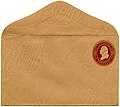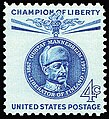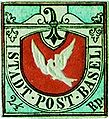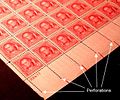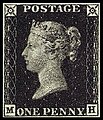Portal:Philately
| Philately portal | WikiProject Philately |
The Philately Portal
Philately is the study of revenue or postage stamps. This includes the design, production, and uses of stamps after they are issued. A postage stamp is evidence of pre-paying a fee for postal services. Postal history is the study of postal systems of the past. It includes the study of rates charged, routes followed, and special handling of letters.
Stamp collecting is the collecting of postage stamps and related objects, such as covers (envelopes, postcards or parcels with stamps affixed). It is one of the world's most popular hobbies, with estimates of the number of collectors ranging up to 20 million in the United States alone.

The Apollo 15 postal covers incident, a 1972 NASA scandal, involved the astronauts of Apollo 15, who carried about 400 unauthorized postal covers into space and to the Moon's surface on the Lunar Module Falcon. Some of the envelopes were sold at high prices by West German stamp dealer Hermann Sieger, and are known as "Sieger covers". The crew of Apollo 15—David Scott, Alfred Worden, and James Irwin—agreed to take payments for carrying the covers; though they returned the money, they were reprimanded by NASA. Amid much press coverage of the incident, the astronauts were called before a closed session of a Senate committee and never flew in space again.
The three astronauts and an acquaintance, Horst Eiermann, had agreed to have the covers made and taken into space. Each astronaut was to receive about $7,000 (equivalent to $51,000 in 2023). Scott arranged to have the covers postmarked on the morning of the Apollo 15 launch on July 26, 1971. They were packaged for space and brought to him as he prepared for liftoff; he brought them aboard in a pocket of his space suit. They were not included on the list of the personal items he was taking into space. The covers spent July 30 to August 2 on the Moon inside Falcon. On August 7, the date of splashdown, the covers were postmarked again on the recovery carrier USS Okinawa. One hundred were sent to Eiermann (and passed on to Sieger); the remaining covers were divided among the astronauts. (Full article...)Selected article -

Presidents of the United States have frequently appeared on U.S. postage stamps since the mid-19th century. The United States Post Office Department released its first two postage stamps in 1847, featuring George Washington on one, and Benjamin Franklin on the other. The advent of presidents on postage stamps has been definitive to U.S. postage stamp design since the first issues were released and set the precedent that U.S. stamp designs would follow for many generations.
The paper postage stamp itself was born of utility (in England, 1840), as something simple and easy to use was needed to confirm that postage had been paid for an item of mail. People could purchase several stamps at one time and no longer had to make a special trip to pay for postage each time an item was mailed. The postage stamp design was usually printed from a fine engraving and were almost impossible to forge adequately. This is where the appearance of presidents on stamps was introduced. Moreover, the subject theme of a president, along with the honors associated with it, is what began to define the stamp issues in ways that took it beyond the physical postage stamp itself and is why people began to collect them. There exist entire series of stamp issues whose printing was inspired by the subject alone. (Full article...)Selected images
-
A 1956 half penny stamp of the British Solomon Islands
-
A magnifying glass is a convex lens which is used to produce a magnified image of an object. The lens is usually mounted in a frame with a handle though other designs are produced. A magnifying glass works by creating a magnified virtual image of an object behind the lens. Stamp collectors frequently use magnifying glasses to inspect their stamps. This photograph shows the magnified image of the Deutsche Post 1 Reichsmark stamp issued on May 12 1946.
-
A military stamp used by the British forces in Egypt around 1935
-
A 1910 Italian stamp commemorating the 50th anniversary of the Expedition of the Thousand
-
Cover sent by Zeppelin from Gibraltar on 20 November 1934 to Rio de Janeiro, Brazil via London and Berlin for the Christmas flight (12th South American flight) of 1934 that took place between the 8th and 19th. The two red "MIT LUFTSCHIFF GRAF ZEPPELIN" and green circular marking were applied by the post office. This is a printed matter item that has been registered.
-
United States newspaper and periodicals stamps of 1875
-
A crash cover is any type of cover, (including air accident cover, interrupted flight cover, wreck cover) meaning any piece of mail that has been recovered from a fixed-wing aircraft, airship or aeroplane crash, train wreck, shipwreck or other postal transportation accident during its journey from sender to recipient. In many cases it was possible to recover some or even all of the mail being carried and the postal authorities typically apply a postal marking (cachet), label, or mimeograph that gets affixed to the cover explaining the delay and damage to the recipient, and possibly enclose the letter in an "ambulance cover" or "body bag" if it was badly damaged and forwarded to its intended destination.
-
Widespread hoarding of coins during the American Civil War created a shortage, prompting the use of stamps for currency. To be sure, the fragility of stamps made them unsuitable for hand-to-hand circulation, and to solve this problem, John Gault invented the encased postage stamp in 1862. A normal U. S. stamp was wrapped around a circular cardboard disc and then placed inside a coin-like circular brass jacket.
-
A postal stationery envelope used from London to Düsseldorf in 1900, with additional postage stamp perfinned "C & S" identifying the user as "Churchill & Sim" per the seal on the reverse shown on inset. A perfin, the contraction of 'PERForated INitials', is a pattern of tiny holes punched through a postage stamp. Organizations used perforating machines to make perforations forming letters or designs in postage stamps with the purpose of preventing pilferage. It is often difficult to identify the originating uses of individual perfins because there are often no identifying features but when a perfin is affixed to a cover that has some user identifying feature, like a company name, address, or even a postmark or cancellation of a known town where the company had offices, this enhances the perfin.
-
Ross Dependency 1957 issue (3 of 4 stamps)
-
Unissued 1956 £1 Jamaican chocolate and violet, the first stamp designed for Queen Elizabeth II. Held in the British Library Crown Agents Collection.[1]
-
Advertising for the stamp dealer Charles Nissen on a booklet pane from the 1929 PUC stamps of Great Britain.
-
This is a very scarce use of the world's first postage stamp, the Penny Black, used on first day of valid use, May 6, 1840, tied by red Maltese Cross cancellation on folded cover to Warwickshire, brown "C MY-6 1840" first day datestamp on backflap verifies date of use. This was sold as lot 1018 at Robert Siegal's 2006 Rarities of the World auction for $45,000.
-
A fawn colored UPSS size 7 stamped envelope, watermark 6, laid paper, US postal stationery envelope from the Plimpton series of 1883.
Did you know (auto-generated)

- ... that Argentinian Ricardo D. Eliçabe qualified as a physician, co-founded a petroleum refinery, and wrote about forgeries of Bolivia's first stamps?
- ... that after Irish post office clerk Maureen Flavin Sweeney reported worsening weather conditions, Dwight D. Eisenhower agreed to postpone D-Day by 24 hours?
- ... that in 1850, about a quarter of the post offices of the Swiss Post were located in taverns?
- ... that an investigation into the Royal Oak post office shootings led one congressman to accuse the Postal Service of having been "asleep at the switch"?
- ... that after the British Army captured New York City in 1776, Samuel Loudon fled to the village of Fishkill, where he founded the state's first post office?
- ... that in 2007, Arthur Gray's £2 Kangaroo and Map stamp sold for a world record price for a single Australian stamp?
General images -
-
A Costa Rica Airmail stamp of 1937 (from Postage stamp)
-
Rowland Hill (from Postage stamp)
-
A 1987 Faroe Islands miniature sheet, in which the stamps form a part of a larger image (from Postage stamp)
-
The main components of a stamp:
1. Image
2. Perforations
3. Denomination
4. Country name (from Postage stamp) -
Postal censorship of 1940 civil cover from Madrid to Paris opened by both Spanish and French (Vichy) authorities (from Postal history)
-
The first officially perforated United States stamp (1857) (from Postage stamp)
-
Lovrenc Košir, 1870s (from Postage stamp)
-
The Penny Red, 1854 issue, the first officially perforated postage stamp (from Postage stamp)
-
The Basel Dove stamp (from Postage stamp)
-
The controversial 1981 United Nations stamp focusing on the "Inalienable Rights of the Palestinian People". (from United Nations Postal Administration)
-
A busy United Nations Post Office at the United Nations Headquarters, New York City (from United Nations Postal Administration)
-
Pre-stamp 1628 lettersheet opened up showing folds, address and seal, with letter being written on the obverse (from Postal history)
-
Le Philatéliste by François Barraud (1929) (from Postage stamp)
-
With the growth of urban centres across the Western hemisphere in the 19th century Post Offices were located on main arterial routes (from Postal history)
-
Rows of perforations in a sheet of 1940 postage stamps (from Postage stamp)
-
Zeppelin mail from Gibraltar to Rio de Janeiro, Brazil via Berlin on the Christmas flight (12th South American flight) of 1934 (from Postal history)
-
A 1979 stamp issued for the United Nations Geneva office, denominated in Swiss francs. (from United Nations Postal Administration)
-
The 1985 postage stamp for the 115th birth anniversary of Vladimir Lenin. Portrait of Lenin (based on a 1900 photography of Y. Mebius in Moscow) with the Tampere Lenin Museum. (from Postage stamp)
-
The first United Nations stamp issued in 1951. (from United Nations Postal Administration)
-
The Penny Black, the world's first postage stamp (1 May 1840) (from Postage stamp)
Selected stamp -

The 1904 Pictorial 4d Lake Taupo invert is an invert error on a postage and revenue stamp issued by New Zealand which is considered to be the country's rarest stamp. The centre vignette is inverted in relation to the outer frame. The stamp was discovered in a schoolboy album in 1930 and no other copy has been found since then.
The 4d stamp depicts Lake Taupō in New Zealand's North Island. It was part of the first pictorial series originally issued in 1898 but reissued in different colours and sizes in 1899 and 1900. The same design was used for a 1d value issued in 1898. (Full article...)List articles

- List of philatelists
- List of most expensive philatelic items
- List of postage stamps
- Lists of people on postage stamps (article) • (Category page)
- List of entities that have issued postage stamps (A–E)
- List of entities that have issued postage stamps (F–L)
- List of entities that have issued postage stamps (M–Z)
- List of postal services abroad
- Timeline of postal history
Related portals
Topics
Categories
WikiProject
![]() WikiProject Philately organizes the development of articles relating to philately. For those who want to skip ahead to the smaller articles, the WikiProject also maintains a list of articles in need of improvement or that need to be started. There are also many red inked topics that need to be started on the list of philatelic topics page.
WikiProject Philately organizes the development of articles relating to philately. For those who want to skip ahead to the smaller articles, the WikiProject also maintains a list of articles in need of improvement or that need to be started. There are also many red inked topics that need to be started on the list of philatelic topics page.
Selected works
- Williams, Louis N., & Williams, Maurice (1990). Fundamentals of Philately {revised ed.). American Philatelic Society. ISBN 0-9335-8013-4.
{{cite book}}: CS1 maint: multiple names: authors list (link) - Hornung, Otto (1970). The Illustrated Encyclopedia of Stamp Collecting. Hamlyn. ISBN 0-600-01797-4.
- Stuart Rossiter & John Fowler (1991). World History Stamp Atlas (reprint ed.). pub: Black Cat. ISBN 0-7481-0309-0.
Wikimedia
The following Wikimedia Foundation sister projects provide more on this subject:
-
Commons
Free media repository -
Wikibooks
Free textbooks and manuals -
Wikidata
Free knowledge base -
Wikinews
Free-content news -
Wikiquote
Collection of quotations -
Wikisource
Free-content library -
Wikiversity
Free learning tools
Other Portals
Sources
- ^ "Philatelic Collections: General Collections". British Library. 2003-11-30. Archived from the original on 30 June 2011. Retrieved 2011-01-16.









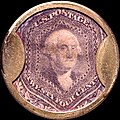


![Image 11Unissued 1956 £1 Jamaican chocolate and violet, the first stamp designed for Queen Elizabeth II. Held in the British Library Crown Agents Collection.[1]](http://upload.wikimedia.org/wikipedia/commons/thumb/9/9b/Stamp_Jamaica_1956_unissued_1sh.jpg/120px-Stamp_Jamaica_1956_unissued_1sh.jpg)


